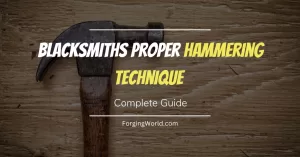Choosing between power hammer and hydraulic press can be tough sometimes, especially if you don’t know enough about them. When you search the internet, you will quickly realize that one group is saying that the power hammer is better while the other one claims the opposite. The truth is usually somewhere in the middle.
So, which one is better for forging, power hammer or press? The significant difference between them is that the power hammer has a fast-moving ram that works like a hammer while the press squeezes the steel more slowly but with a higher power. Power hammers are better for drawing out the metal but also more expensive. Contrarily, presses are usually easier to make and more suitable for making pattern-welded steel.
Keep in mind that many other factors will influence buying decision between the two. That is why it is crucial to know more information about them. Next, we will explain each of them and also their advantages and disadvantages so you can make the best decision.
Power Hammer
Advantages
- Ideal for fast drawing out the material
- Directly more related to the anvil and a hand hammer
- It cools less the material
- It is highly versatile
- Allows to see the work more clearly
Disadvantages
- More expensive
- Harder to DIY
- Produce a lot of noise
- Usually not neighbor-friendly
What Is a Power Hammer?
A power hammer is a power tool that contains a fast-moving ram that acts as a hammer. It uses a non-muscular power source to operate. A power hammer is also called “Open Die Forging Hammer.” It is commonly used by manufacturers, blacksmiths, and manufacturers since the 1880s.
It generally consists of an anvil, ram, hammer die, and a frame. You place the material on the lower die, and the upper one strikes it. Power hammers are usually classified by the weight of the moving parts. Blacksmiths and bladesmith commonly use it for quick drawing the material. Compared to the press, the power hammer is also directly more related to the anvil and a hammer.
In part, this is why using a power hammer usually requires less experience than the press. Beginner blacksmith already has that feeling of hammering, so it is typically easier to move into power hammer than on the press. I should note here that the person must first master the anvil and hand hammer, before even thinking about using the power tools like power hammer and press.
Know that a power hammer or any other power tool will not make you a more skilled blacksmith. If you don’t know how to forge with a hand hammer, making the transition to power tools will make things even worse. If you don’t know how to make proper micro-adjustments of material while striking a much slower hand hammer, imagine using the power hammer, which produces 2-3 blows per second.
That leads us to another advantage of a power hammer. Namely, power hammer is in contact only for a second, and then it blows up longer than when it is striking. That means it basically allows you to see the work much better every time the head is up.
Previously mentioned is also related to the following advantage of power hammers. Power hammer also allows making micro-adjustments like tilting, moving up and down, and side to side, which is especially beneficial for beginner/intermediate blacksmiths. So, if you want to move onto using power tools, we recommend using the power hammer first as it is easier to manage properly.
What you may also notice is that when using it, top of the material tends to move more than the bottom. That is mainly due to the fact that the top ram contains more kinetic energy and less energy when rebounding from the bottom.
In regards to drawing out, a power hammer is a winner in most cases. There is also much less risk of losing heat quickly, so you don’t have to make a lot of adjustments or put it back in the forge.
I should note that many blacksmiths can make the same object by using either of the two, so many of them prefer one over the other more for subjective reasons. For example, you can make the knife with a power hammer and press, it is just a matter of personal experience and preferences. The ideal thing would be having both of them, but many people can afford barely one of the two, let alone both.
As you can already assume, power hammer tends to produce a lot of noise, which can present a problem with neighbors, especially if you live in some residential area. That is why proper mounting is crucial to reduce the amount of noise. I guarantee that your neighbors will be very grateful.
One of the most critical factors in mounting a power hammer is to have a good basis, like concrete, for example. It is a much better choice than wood. Make sure to have at least 6 inches of concrete. If you have less than that, you may want to cute a hole with a concrete saw and dig a 3 feet deep hole.
After that, it is vital to isolate the edges before filling the hole with concrete. One of the best ways of fixing a power hammer or any machine is using chemical anchors. Simply drill the hole, clean it out, and put your resin and stud in.
It is also a good idea to put some extension on the treadle to achieve a long stroke of the treadle. That is very helpful as longer the stroke, the greater control you have.
In terms of safety and maintenance precautions, we recommend:
- Regular checking of oil and grease
- Adjusting linkages as they loosen
- Making sure that bolts and nuts are correctly tensioned
- Motor or air compressor maintenance when needed
- Belt dressing when needed
- Wearing safety glasses
- Knowing the position of the material and tooling at all time
- Removing trip hazards from the work zone
Hydraulic Press
Advantages
- Cheaper than power hammer
- Easier to DIY
- Produce a minimum level of noise
- Ideal for making pattern-welded steel
- Adaptable with dies
- Neighbor-friendly
- It is versatile
Disadvantages
- Usually require more experience
- Cools down the material quickly
- Not ideal for fast drawing out
- Not ideal for thin work
What is Hydraulic Press?
A hydraulic press is a machine that produces a compressive force by using a hydraulic cylinder. It relies on Pascals Principle, which states that the pressure at a point has infinite direction, so the pressure is transmitted throughout the liquid.
Hydraulic press contains a piston that acts as a pump that provides just enough mechanical force to a small area of the material. It also contains a larger piston, which can produce a more significant mechanical force. Press usually consists of an electric pump, hydraulic ram, and frame with removable dies.
Presses are ideal for moving a lot of material at once, especially for billets. They can usually move the center of the material more efficiently than the surface, which can be a pro and a con, depending on the type of working project. Unfortunately, presses cool down the material much faster than power hammers, as they squeeze the material for 2-3 seconds. Keep in mind that heat is cooled way faster in winter than in the summer, so the time of the year also plays a significant factor.
In a single heat, you can work on multiple parts of the process and also use various tools under the press. As power hammers, presses also present a lot of versatility. Unfortunately, presses allow adjusting the material only for a limited amount of time. That can sometimes present a problem for those who don’t have much experience.
Hydraulic presses tend to deform items like an eye when drifting or punching. Namely, the amount of pressure that presses applies is so great that bulges things out to the side. If you are making pattern-welded steel, presses are the ideal choice.
As you can see, presses are more convenient for thicker pieces of material rather than thin ones. The good thing is that on a hydraulic press, you can quickly change the dies. For example, if you want to squash the metal flat, use the flat dies. Contrarily, to draw out the material, use the round dies.
Presses are also much less expensive and easier to make it yourself. One of the greatest advantages of presses is the fact that they produce a minimum level of noise, which is excellent news for your neighbors.
In terms of safety and maintenance precautions, we recommend:
- Regular replenishing of oil
- Regular pump maintenance
- Motor maintenance when needed
- Changing the tank filter as needed
- Wear safety glasses
- Installing shields
- Removing trip hazards from the work zone



